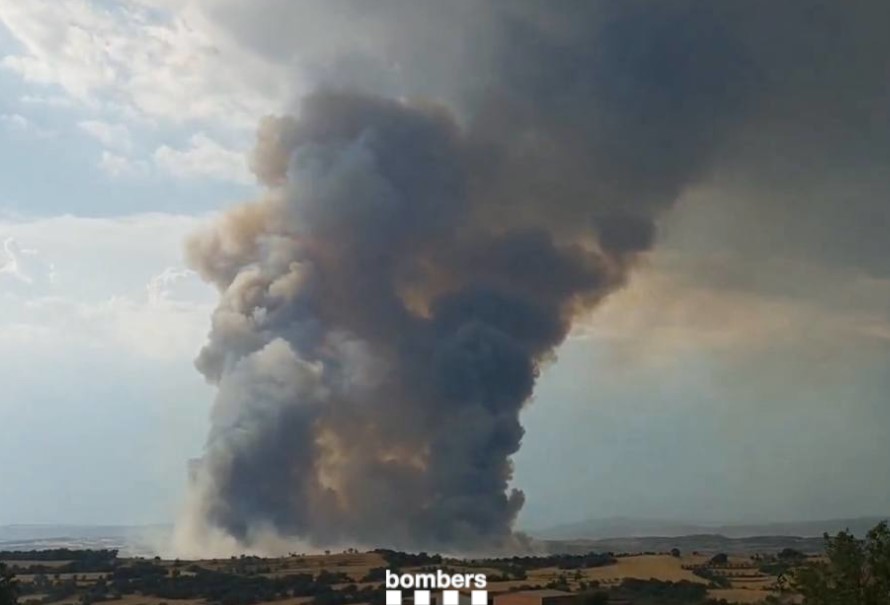In the picturesque region of La Segarra (Lleida), Spain, a tragic catastrophe unfolded on Tuesday: two devastating agricultural fires, classified as “sixth-generation fires,” claimed two lives near the center of Coscó and scorched approximately 6,500 hectares of land. These unprecedented fires kept emergency services and the population on edge, highlighting the increasing intensity of extreme weather events.
Tragic Loss: The Victims of the Flames in Lleida
The Mossos d’Esquadra are currently investigating the circumstances of the two victims’ tragic deaths. It is believed that a farm worker encountered difficulties due to the extreme conditions. The farm owner rushed to his aid in his 4×4, but the vehicle became trapped by the flames. Both men exited the car but were later found lifeless next to the charred vehicle by firefighters. Interior Minister Núria Parlon confirmed the ongoing investigations and emphasized the need to clarify the exact circumstances of the incident.
The Battle Against the Blaze: Firefighters in Continuous Operation
Around fifty firefighters were on duty all night fighting the flames. After an intensive search, they have ruled out any further fatalities within the perimeter of the fire. Emergency services do not expect to bring the fire under control before late afternoon, when temperatures are expected to drop. Although the burnt area is estimated at 6,500 hectares, not all of it has been consumed by fire. The Rural Agents are responsible for accurately assessing the burnt and damaged area. Fortunately, two slightly injured firefighters are recovering well from their injuries.
Continuem treballant en els incendis de vegetació actius a #IVTorrefeta i #IVSanaüja, on hem apagat una masia deshabitada.
— Bombers (@bomberscat) July 1, 2025
📹 Imatges de les 19.18 hores a #IVTorrefeta.#bomberscat pic.twitter.com/vTpNOZ3PPo
“Sixth-Generation Fires”: A New Dimension of Danger
The fires, classified as “sixth-generation fires,” are particularly intense and fast-moving due to the high temperatures of recent days. The phenomenon was further complicated by the forecast of new storms that could reactivate the fire sources. Thanks to the tireless efforts of the fire department, the fire was stabilized on Tuesday around 10:37 PM. The head of the extinguishing operation, Joan Josep Bellostas, explained to TVE that stabilization means no further growth is expected in the coming hours. Nevertheless, it is essential to continue operations, as it is a very wide area that still needs to be soaked. The interaction of crops and fuel in the area, combined with the persistent heat, poses a constant challenge. The support from farmers’ tractors, which help to reinforce and secure the fire perimeter, is invaluable.
20,000 People Trapped: A Region in a State of Emergency
The first fire, which originated in Sanaüja and Ribelles, was already considered stabilized by Tuesday afternoon. The second fire in Torrefeta i Florejacs, which affected a larger part of the land, was only brought under control late at night, as it had repeatedly reignited due to strong winds and unfavorable weather conditions. The extreme winds, with gusts of up to 100 km/h and a spread rate of 30 km/h – the highest recorded spread in Europe – significantly contributed to the rapid spread of the flames. Fortunately, rainfall in the region helped to stabilize the situation.
The rising smoke plumes from both fires reached a height of up to 14,000 meters – a phenomenon never before seen in Catalonia. The Civil Protection then ordered the confinement of 20,000 residents in nine municipalities: Agramunt, Artesa de Segre, Vilanova de l’Aguda, Guissona, Sanaüja, Torrefeta, Oliola, Cabanabona, and Ponts. Traffic on the C-14 between Artesa de Segre and Tàrrega was cut off. The ES-Alert system warned the first 450 affected people via mobile phone, urging them to keep doors and windows closed and not to leave their homes. Almost the entire affected area lies within the boundaries of the Espai Natural Protegit Valls del Sió-Llobregós. The Rural Agents have activated investigation protocols to determine the origin of the fire. It is suspected that the fire was caused by agricultural machinery.
Outlook and Continued Struggle
Firefighters believe that the fire in Torrefeta i Florajacs can be brought under control at least by late afternoon when temperatures drop. Operations chief Albert Castellet emphasized that outbreaks must be controlled and the simultaneous spread of further fires due to high temperatures must be avoided. The greatest concern is currently the right flank of the fire, where the flames could potentially spread into the Segre Valley. The relentless fight against the flames continues until the danger is finally averted.




